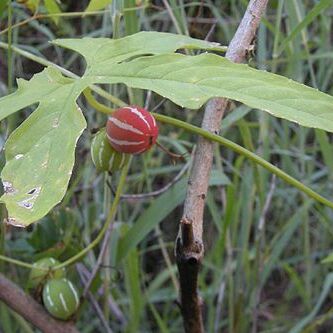Subannual or perennial climbers; monoecious. Probract present. Tendrils 2-branched. Leaves: blade simple, (deeply) palmately lobed. Inflorescences (from D. palmatus): male flowers few to many in fascicle-like short racemes, female flowers 1-5 co-axillary with male flowers, or in fascicle-like short racemes, or solitary; flowers pale greenish (creamy-)yellow. Male flowers: receptacle-tube cup-shaped, narrowed to the base; sepals small, linear; corolla of partly fused petals, lobes entire; stamens 3, inserted in upper part of the receptacle-tube, anthers two 2-thecous, one 1-thecous, anthers free but coherent, thecae plicate, connective broad; disc low, annular or indistinct. Female flowers: perianth as male flowers; ovary (broadly) ovoid or subglobose, ovules few, horizontal, style 3-armed, stigmas ± 2-lobed, papillose; staminodes 3, elongate; disc inconspicuous. Fruit berry-like, solitary or few-fascicled, broadly ovoid or ellipsoid or subglobose, shortly rostrate or not, exocarp thin. Seeds tumid, pyriform with strongly convex faces, margin thick, edge grooved.
Monoecious climbing or trailing perennial herbs, pubescent to glabrous. Tendrils 2-branched. Leaves simple, palmately lobed. Male flowers in axillary fascicles or short racemes; hypanthium broadly campanulate; calyx 5-lobed; corolla deeply 5-lobed, white to yellow; stamens 3, inserted towards base of hypanthium; anthers 3, on short filaments, cohering, two bilocular, one unilocular; locules flexuose, triplicate; disc absent. Female flowers in axillary fascicles or solitary, often co-axillary with males; perianth similar to males; staminodes 3, subulate; ovary subglobose to ovoid; ovules few; style inserted in annular disc; stigma 3-lobed. Fruit fleshy, indehiscent, ellipsoidal or ovoid. Seeds few, obovate, turgid, margined.
Herbs, scandent. Tendrils 2-fid. Leaf blade palmately 5-lobed. Plants monoecious. Flowers small, fasciculate, often male and female flowers together in axils. Male flowers: calyx tube broadly campanulate; segments short; corolla broadly campanulate; segments ovate; stamens 3, free, inserted on calyx tube; filaments short; anthers ovoid, one 1-celled, other 2-celled; anther cells linear, slightly flexuous. Female flowers: calyx and corolla as in male flowers; staminodes 3; ovary globose or ovoid, with 3 placentas; ovules few, horizontal; style slender; stigmas 3, 2-lobed. Fruit baccate, globose or ovoid. Seeds strongly margined, surfaces slightly scrobiculate at middle.
Female flowers subsessile; ovary terete; ovules rather few, horizontal; receptacle-tube smaller and narrower than in male flowers, perianth otherwise similar; stigma 3-lobed.
Fruits solitary or clustered, subsessile, baccate, fleshy, globose to ellipsoid, indehiscent, red with white longitudinal stripes or lines of markings.
Stamens 3, 2 double two-thecous, 1 single one-thecous, free; filaments inserted on the receptacle-tube; connectives broad; thecae flexuous.
Flowers monoecious, in sessile or shortly racemose few-to many-flowered axillary clusters, male and female often co-axillary.
Seeds rather small, pyriform, with highly convex faces and thick 2-grooved, rugulose margins.
Corolla whitish or pale yellow, gamopetalous, 5-lobed, the lobes entire.
Receptacle-tube short and broad; lobes small, remote.
Scandent perennial herbs; young stems green-spotted.
Disk ± undulate, adnate to the receptacle-tube.
Leaves petiolate, simple, palmately lobed.
Male flowers on slender pedicels.
Tendrils proximally 2-fid.
Probracts present, small.

